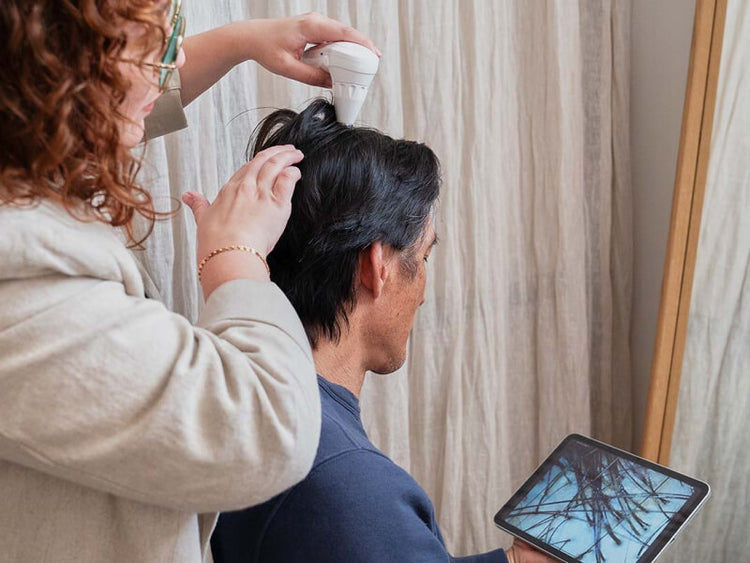First of all: there’s no such thing as bad or good hair, but healthy hair is very real – and attainable. While most people have an understanding of their skin type (and possibly a multi-step routine to match it), for many of us, our hair type is something we have guessed – piecing information together via various sources from online tutorials to hairstylists, friends, family and beyond.
Different hair types require different care, so knowing your hair type is integral to treating it correctly. Approaching your strands from the wrong angle can lead to unmanageable, unhealthy strands and – just like with your skin – the right routine can lead to incredible results.
When we talk about hair types, what do we mean?
Hair type is the natural texture of the lengths of the hair. Characteristics that define hair type include the shape of the follicle, thickness of strands, and if the hair holds any curl or wave pattern.
Which hair types benefit from hair masks?
Hair type is determined by genetics – as your DNA influences the shape of your follicles.
What are the different hair types?
We can break down the different hair types into four categories: straight, wavy, curly, and coily. Each of these hair types can vary in thickness.
- Straight Hair
Straight hair comes from round or slightly oval-shaped follicles. This hair type can often feel light or feathery in texture, but this isn't always the case. The structure of straight strands allows the sebum produced in the follicles to slide easily down the lengths of the hair. Improper care of this hair type can cause it to look or feel greasy if there is excess sebum. People with straight hair may experience a lack of volume – especially when the hair's growth angle is very flat or if hair miniaturisation is occurring. (More on miniturisation later.) - Wavy Hair
Wavy hair grows from oval-shaped follicles. This hair type can present as a slight wave that's easy to straighten, a loose S-pattern with little to no bounce, or a defined deep wave. This hair type can feel a little drier than straight hair because it is more challenging for the sebum to distribute. Improper care of this hair type may cause a lack of volume at the root, increased frizz, or loss of waves and shape over time. - Curly Hair
Curly hair comes from oval to elliptical-shaped follicles. This hair type can be a loose spiral with minimal shrinkage, springy ringlets, or tight corkscrew curls. Improper care of this hair type may lead to loss of curl, inconsistent curl pattern, increased frizz, and dryness. - Coily Hair
Coily hair grows from flat, oval-shaped hair follicles. This hair type can be tight curls wrapping around themselves, dense zigzag curls, or tightly coiled curls to the point that you may only see the zigzag pattern if you stretch the strands. Improper care of this hair type can lead to scalp issues due to difficulty cleansing high-density hair, dryness or breakage.
How do you identify your hair type?
To figure out your hair type, we recommend taking a few hours at home or even the whole day – as the process requires you to cleanse your hair and leave it free from styling products or hot tools.
- Cleanse and condition as normal.
- Once out of the shower, gently detangle your hair with your fingers or a wide-tooth comb without adding any product.
- Allow your hair to air dry completely.
- Review your hair by sight and touch.
These are some questions you will find the answers to:
- Are your hair strands straight or do they take on more of a curl?
- Does your hair feel soft to the touch or does it feel coarse and rough
- Is your hair dry and frizzy or is it more to the oily side, and stuck together?
- Is it challenging to part your hair or does it part easily.
Here are some defining characteristics of each hair type that you may notice after your review:
Straight Hair: your hair lies flat on the scalp, has no hint of wave or curl and lacks volume.
Wavy Hair: your hair dries with an S-shape, may be frizzy and be flatter at the crown with waves appearing around the mid-lengths.
Curly Hair: you have defined ringlets, perhaps with tangle-prone, dry lengths and/or frizz, and hair texture starts to curl at the root.
Coily Hair: you have considerable shrinkage of hair lengths once it dries with tight ringlet curls that start at the root.
Keep in mind that your hair might fit into two or more categories. For example, your hair lies flat on top but underneath (near the nape of the neck) is wavy or your curl pattern isn't consistent all over your head, perhaps with curly roots and straighter ends. These variations in hair texture might be due to poor scalp health, improper hydration of the strands, damage, or hair miniaturisation.
Does hair density or thickness affect hair type?
No, your hair type is determined by genetics. However when your hair density and strands are reducing in quality, your hair can change in appearance. We see many clients in our clinics who used to have thick, curly, lustrous hair that could easily be grown long, but over time their hair has transformed to become thin, frizzy and dull, and can only grow half the length it used to.
Hair Density
This refers to the number of hair strands on your scalp per square inch. Genetics determine the hair density your body is capable of producing. This is classified as low, medium, or high. People with low hair density tend to have fewer hairs per square inch, while those with high hair density have more hairs per square inch. Your hair density can be influenced negatively by an interaction between your genetics and your hormones, leading to miniaturisation of hair follicles and eventual decline in hair density over time, which can start as early as your teens.
Hair Thickness
This is the actual thickness or diameter of individual strands. Genetics determine whether you have fine, medium, or coarse hair. People with fine hair tend to have more wispy-feeling strands, while those with coarse hair often have strands that feel more dry or rough. Similarly to density, your hair thickness can be influenced negatively by an interaction between your genetics and hormones, leading to miniaturisation of hair follicles and a decline in your strands’ size and length.
Do people with specific hair types deal with hair loss more commonly than others?
No particular type of hair is more prone to loss. People with all hair types should take a scalp-first approach to achieving (or maintaining) dense, full, healthy hair.
What is androgenetic hair thinning?
The most common type of hair thinning is androgenetic – an interaction between genetics and hormones – but this type of hair thinning can be exacerbated considerably by inadequate and incorrect cleansing routines, which can throw off the scalp’s sensitive biological environment and lead to scalp irritation, inflammation, and hair thinning.
What is hair miniaturisation?
When it comes to hair thinning, the follicle undergoes a miniaturisation process due to the interaction between hormones and genetics. Miniaturisation is the result of hair follicles gradually shrinking in size, which means the life cycle of the hair also decreases. This means once the hair falls out, the hair that regrows in its place is not of the same quality and grows back at a smaller diameter, which results in decreased coverage and density. These strands become thinner, weaker, more transparent and cannot grow for as long of a period. Over time, some hair follicles will eventually scar and no longer produce hair at all.

What are the best routines for each hair type?
Straight Hair
Since a straight hair type can be prone to higher oil production, daily washing will often be necessary to help regulate excess sebum. While strands might be more easily coated in sebum, it’s still important to condition – but only from the ears down.
Straight Hair Essentials: Balancing Shampoo, Stabilizing Scalp Shampoo, Daily Conditioner.
Wavy Hair
People with wavy hair types will need to cleanse daily or every second day, but also need to keep hydration in mind to enhance the hair’s texture. That means always conditioning on wash days and using leave-in conditioner, as well as applying a hair mask once or twice a week. This will increase softness and shine, while reducing frizz.
Wavy Hair Essentials: Stabilizing Scalp Shampoo, Fortifying Shampoo, Daily Conditioner, Hair Hydrating Crème, Hair Mask.

Curly Hair
Similar to those with wavy hair, individuals with curly hair types need to focus on hydration. After cleansing daily or every second day, be sure to apply conditioner and then leave-in conditioner. For people with dehydrated and tight curls, using our Hair Mask as a styling product can increase hydration, help to hold curls in place and reduce frizz.
Curly Hair Essentials: Stabilizing Scalp Shampoo, Fortifying Shampoo, Hair Hydrating Crème, Hair Mask.
Coily Hair
For those with coily hair, it is vital to ensure the scalp is thoroughly cleansed, as it can be challenging to shampoo the scalp properly due to the high hair density. The frequency of washing can vary with this hair type. For some people, shampooing every second or third day may be suitable, but for others once per week or every 10 days can be sufficient.
Coily Hair Essentials: Stabilizing Scalp Shampoo, Fortifying Shampoo (especially for people with very little oil production), Hair Hydrating Crème, Hair Mask.


